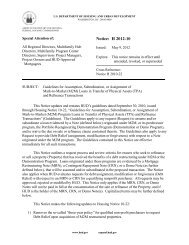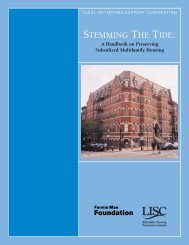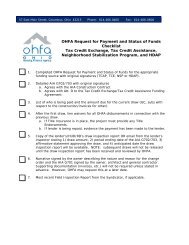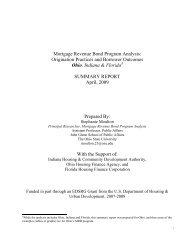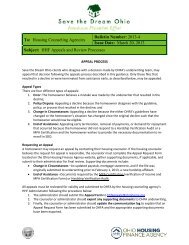OHFA Annual Plan - Ohio Housing Finance Agency
OHFA Annual Plan - Ohio Housing Finance Agency
OHFA Annual Plan - Ohio Housing Finance Agency
Create successful ePaper yourself
Turn your PDF publications into a flip-book with our unique Google optimized e-Paper software.
• The cost of construction often exceeds the appraised value for single family homes.• In some areas the income limits used by HUD statistics are influenced by MSA’s thathave major population areas in another state (i.e. Lawrence County) or influence ofadjacent metropolitan areas within the state.• HUD’s published income limits are stagnant in most rural areas. The census data isupdated between the decennial censuses for larger populated areas but not as readilyupdated in rural areas. Therefore, there are clients who should be eligible for programsthat are being left out.• Financial education at a younger age in the <strong>Ohio</strong> schools is necessary. In rural andAppalachian areas, we are seeing more young people destroy their credit. We havealso seen an increase in parents using their children’s information to access credit anddamage children’s credit before they are of age.• Some rural counties are affected by a large city with a good but limited employmentbase. One example is Athens which has <strong>Ohio</strong> University. Rents are higher based on thedemand by college students; however the rents are too high for permanent residents inthe area to afford.• The job opportunities in rural areas are few so when a major employer leaves the arearesidents do not have other choices for employment. In addition, with rising gas prices,it is more difficult for the rural resident who may have to travel many miles to work.• In the rural areas there is a large uncounted homeless population. Many of these areyouth who have left the home and move from house to house.• There is a lack of support for CHDOs in rural areas. In many cases there is only onenon-profit developer in a county or several surrounding counties. If they are notsupported, there is no one to take over the work they are doing, and it may take manyyears for someone else to build the capacity. This differs in the urban areas where thereare often several nonprofit developers in one city. We recommend an annual set-asideof operating funds for rural CHDOs with special consideration for areas of distress (i.e.poverty, high foreclosures, vacancies, etc.).• Services for special needs, case management, and supportive services are limited in therural communities. There are cases where a limited number of permanent supportivehousing units are needed but not an entire complex. An allowance for a mixeddevelopment with some permanent supportive housing units is needed.• There is a concern that many federal programs are shifting funding from a direct loanprogram with subsidy to a guaranteed loan program. Although this may be less costly tothe federal budget, it does not serve the same clientele.• Foreclosures and vacant homes continue to be a problem in all areas of <strong>Ohio</strong> and manyother states. Although urban areas are typically noticed more due to concentration,the rural areas of the state are also suffering with large increase in foreclosures (somecounties with a 50 percent + increase over the past year) and vacant homes due toforeclosures.93



